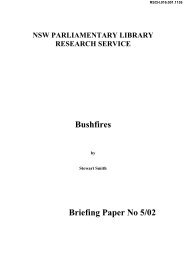Chapter 4 - Warnings - 2009 Victorian Bushfires Royal Commission
Chapter 4 - Warnings - 2009 Victorian Bushfires Royal Commission
Chapter 4 - Warnings - 2009 Victorian Bushfires Royal Commission
You also want an ePaper? Increase the reach of your titles
YUMPU automatically turns print PDFs into web optimized ePapers that Google loves.
<strong>2009</strong> <strong>Victorian</strong> <strong>Bushfires</strong> <strong>Royal</strong> <strong>Commission</strong>—Interim Report<br />
4 WARNINGS<br />
4.223 The CFA siren was activated in Boolarra shortly after 1:00pm that day. A large number of people evacuated<br />
the town. The main street was described as filled with caravans, boats and horse floats hooked up to cars<br />
heading for Churchill. 285<br />
4.224 Mr Sigmund’s direction to use the siren was contrary to CFA policy. Mr Sigmund was aware of the policy<br />
against use of the brigade siren and he was chastised for its use. 286 He attested that he had received<br />
‘nothing but positive feedback from townspeople. They have written letters; rung me and given me nothing<br />
but support for the actions I took’. 287<br />
288<br />
4.225 Mr Sigmund, by his own account, acted on the spur of the moment. He accepted that his decision carried<br />
risks and that if the fire had come from another direction, he might have been sending people into danger. 289<br />
In this context, Mr Sigmund expressed the view that the ‘stay or go’ policy is impossible for ordinary people<br />
to apply, because there are no trigger points to allow the average resident to make a judgement as to their<br />
safety. 290 He said: ‘that is why at the meeting we decided to give them a trigger in the form of a siren’. 291<br />
292<br />
4.226 Twenty nine houses were lost in the fires at Boolarra but no-one died. Despite the siren being used in a<br />
manner that is contrary to CFA policy, it appears to have served a useful purpose in warning townsfolk to<br />
leave. Many appear to have acted on that trigger.<br />
4.227 Mr Rhodes expressed serious reservations about the use of sirens, but he did note that the siren worked<br />
in Boolarra on that occasion because its use was defined at the community meeting and the residents<br />
understood its use. 293<br />
4.228 In addition, Mr Lawson gave evidence that sirens are used in South Australia to alert the community<br />
to the activity of the fire service. The South Australian CFS encourages local brigades to engage with<br />
their communities and to use sirens for purposes determined by the community in consultation with<br />
the brigade. 294 Some brigades use sirens to alert the community to fire, others do not. Mr Lawson said:<br />
‘We leave it to the brigade to make that decision with the community’. 295<br />
USE OF SIRENS AND REFUGES<br />
4.229 There is also evidence before the <strong>Commission</strong> concerning the use of sirens in a number of communities<br />
in conjunction with the use of refuges. One such community is Walhalla. The town of Walhalla uses the<br />
Long Tunnel Mine as a refuge. 296 The use of this refuge is described in more detail in <strong>Chapter</strong> 8.<br />
Woods Point also has an established procedure for the use of a siren in conjunction with its refuge. 297<br />
4.230 The <strong>Commission</strong> also heard evidence about the use of a police car siren as a means of getting people’s<br />
attention in Marysville. 298<br />
Support for a new approach TO THE USE OF SIRENS<br />
4.231 Mr Esplin accepted in evidence that individual communities who support the use of sirens as a means of<br />
taking action to preserve lives and property should be supported by agencies in doing so. 299 Mr Rees also<br />
accepted that the use of sirens should be reconsidered. 300<br />
4.232 There is potential for more communities to attempt a comparable approach as that in use in Ferny Creek,<br />
Walhalla or Woods Point. Not all communities will want to institute a local alert siren. Some communities<br />
will determine to use their siren in different ways for different purposes. The option to pursue local solutions,<br />
including sirens, should be part of Municipal Emergency Response Plans and should also be given more<br />
prominence and assistance in the education campaigns and advice concerning bushfire preparedness.<br />
As Mr Esplin notes in relation to the Ferny Creek fire alert siren:<br />
The community should not be just a passive recipient of services; it should be an active participant<br />
in developing safety strategies that it knows how to apply and is willing to apply, and applies, and<br />
it is involved in a partnership with the emergency services and with local government … and it is<br />
my philosophy that where such a tripartite partnership can be recreated, the safety outcomes are<br />
maximised, but risk is mitigated to the greatest extent. 301<br />
150
















